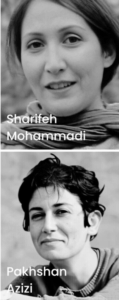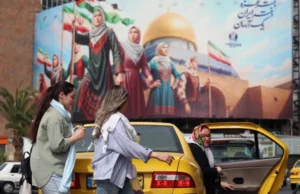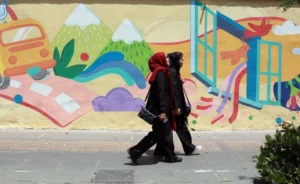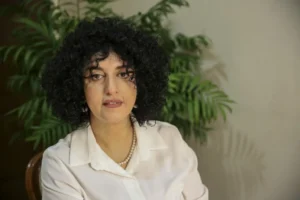Anyone who watched the recent interview with Sara Afzali, an Iranian artist who has been living in Slovenia with her family for seven years, on the public broadcaster Radio-Television Slovenia – RTVS, would have easily concluded that the situation of women in Iran has visibly improved. But the truth is that women are still treated as second-class citizens by the authorities there, and repression of women has intensified since the end of the war with Israel, warns Narges Mohammadi, an Iranian human rights activist and Nobel Peace Prize laureate.
“We really had a revolution. This is the biggest women’s revolution in history. I can go to Iran today as a woman without my hijab, and no one will stop me or arrest me. That changed immediately after the revolution because of Mahsa, who was very successful. We are proud of that. If someone says that we are still being persecuted, that is not true. We may have gotten a wrinkle or two more, but our revolution was successful,” said the Iranian artist Sara Afzali, among other things.
Amnesty International report reveals a very different picture
As Amnesty International’s 2024 report (available at the following link: https://www.amnesty.org/en/location/middle-east-and-north-africa/middle-east/iran/report-iran/) reveals that the authorities have stepped up their repression of women who defied the law on the compulsory wearing of headscarves, RTV Slovenia’s reporting seems all the more unpalatable. The report states that the authorities have further repressed the rights to freedom of expression, association and peaceful assembly. “Women and girls, LGBTI people, and ethnic and religious minorities experience systemic discrimination and violence,” the report states.
It also states that women continued to be treated as second-class citizens by the authorities, including in the areas of marriage, divorce, child custody, employment, inheritance and political office. The legal age of marriage for girls remained at 13, and fathers had the option of forcing their daughters to marry at an even younger age.
The authorities used politically motivated charges against women human rights defenders, punishable by the death penalty. Sharifeh Mohammadi was sentenced to death in June, and Pakhshan Azizi in July. “From April onwards, the authorities implemented the Noor Plan to intensify their crackdown on women and girls who defied compulsory veiling, including through digital surveillance such as facial recognition technology, further violating women’s social, economic, cultural, civil and political rights and restricting their freedom of movement. Increased security patrols subjected women and girls to harassment and violence in public spaces.” The repression, they said, included a ban on education for female students, the use of dangerous car chases to stop women drivers on the roads, the mass seizure of women’s vehicles, forced courses on “morality”, imprisonment and flogging.

Using digital tools to carry out intimidation
Iranian police also started using digital surveillance to identify and punish women who defy the Islamic State’s strict dress code. Like many women in Iran, Darya is used to living with a sense of surveillance. But the 25-year-old financial analyst from northern Tehran says that in recent months, she never knows who might be watching her every move.
She says she has received messages from the police warning her about alleged violations of the strict hijab laws, but last November, she even received a text message with the number plate of her car, giving the exact time and place when she was filmed driving without her head properly covered. She was also warned that the next time this happened, her car would be impounded. “When you receive these messages, you don’t know who reported you – and the police never seem to have evidence of wrongdoing,” she pointed out, according to the Guardian (article is available at the following link: https://www.theguardian.com/global-development/2025/mar/24/iran-police-women-surveillance-hijab-drones-dress-code-law?utm_source=chatgpt.com).
After widespread outrage last year, the Iranian authorities announced that they would suspend the implementation of tough new hijab laws, which impose draconian penalties – including fines and jail sentences – on women who break mandatory dress rules. “Despite these intimidation tactics, many of us have stopped wearing the hijab.” But women in Iran report that state surveillance is steadily increasing.
In March, the UN Fact-Finding Mission reported on Iran’s increasing reliance on digital surveillance, such as the Nazer mobile app, a state-run platform that allows citizens and police to report women for alleged violations. The app can only be accessed through the national information network, which is controlled by the state. Those who wish to participate in the surveillance of hijab wearing are given access to the app, through which they can then file reports, which are then forwarded to the police.

According to the UN Mission, the app has recently been extended to allow users to provide the exact time, location and licence plate of the car in which a woman was seen without her hijab. It can now also be used to report women for hijab violations in public transport, taxis and even ambulances. According to the UN report, aerial drone surveillance has also been used at events such as the Tehran International Book Fair and on Kish Island, a tourist destination, to identify women who do not respect the hijab law.
The government has also stepped up online surveillance, blocking women’s Instagram profiles for non-compliance with hijab laws and issuing warnings via text messages. Surveillance at universities was stepped up through security surveillance cameras and facial recognition technology. “This ‘digital repression’ not only stifles academic freedom, but also causes increased psychological stress among students,” says a spokesman for the Iranian students’ media group Amirkabir Newsletter.
Skylar Thompson, Deputy Director of the Human Rights Activists organisation in Iran, says the app represents a dangerous escalation of the regime’s digital surveillance efforts. “Not only does this app reinforce gender discrimination and foster a culture of fear, but its flaws also raise serious concerns about unjustified arrests and detentions.” Last July, 31-year-old Arezoo Badri, a mother of two, was shot and paralysed after a police officer opened fire on her vehicle for allegedly flagging her car for a hijab violation.

But Darya, like many others, is resolute in her defiance. “If you walk the streets, you will see that many of us have stopped wearing the hijab despite these bullying tactics,” she says. “The money they spend on this surveillance could actually help some people survive,” she points out.
The regime is spreading repression against the Women, Life, Freedom movement
It is well known that a crackdown to find Israeli spies was launched in Iran after the end of the war between Israel and the USA. PBS News (https://www.pbs.org/newshour/show/iran-is-intensifying-its-crackdown-on-dissent-nobel-laureate-narges-mohammadi-says) recently spoke to Iranian human rights activist and Nobel Peace Prize laureate Narges Mohammadi. “In times like these, the Islamic Republic uses every tool at its disposal to intensify its repression of the Iranian people,” she explained, adding that the country is using the war with Israel as an excuse to intensify its repressive measures. “I witnessed Islamic Revolutionary Guard Corps forces in Tehran stopping cars and dumping all the passengers’ belongings into the street, supposedly while searching for drones. It’s an insult to the intelligence and dignity of the Iranian people,” she said.
Mohammadi says the regime is spreading repression against the Women, Life, Freedom movement, which started after the death of Mahsa Amini in 2022 in police custody, after she was arrested for not wearing a headscarf. “Over the past few days, I have received reports that even women sitting quietly in cafes wearing headscarves, but not full veils, were confronted by armed guards who stood over them and ordered them to cover more fully. This shows that the Islamic Republic is now using this opportunity to intensify its campaign against women,” she made it clear.

“Civil society activists, especially women’s rights defenders and media figures, are under intense pressure. Many have been summoned for questioning, visited by security forces,” she explained, adding that their families and lawyers have no information about their whereabouts. “The regime claims it is cracking down on spies, but, in reality, it’s suppressing the democratic movement.”
Human rights groups say Iran has executed at least six people for spying for Israel since the Israeli attack on the 13th of June. The Iranian Parliament has moved to fast-track a bill that would make espionage or cooperation with hostile governments punishable by death. “If enacted, it will dramatically expand the scope and frequency of executions in Iran. We’re likely to see more prisoners placed on death row. The consequences of this law will be extremely severe,” warns Mohammadi.
If RTV Slovenia had interviewed Mohammadi, we would undoubtedly have gotten a more realistic view of the situation there, rather than propaganda that makes a mockery of Iranian women, who are true fighters, when, despite fearing for their lives, they fight for rights that are taken for granted in democratic systems.
S. K.


